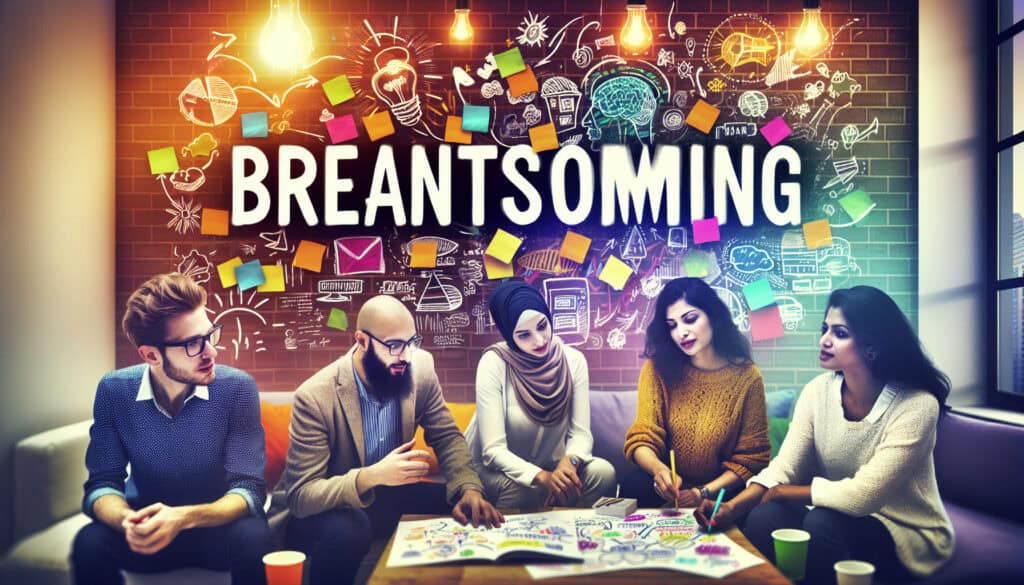Technique de créativité de groupe par laquelle on s'efforce de trouver une solution à un problème spécifique en rassemblant une liste d'idées apportées spontanément par ses membres.
- Méthodologies : Clients et marketing, Conception de Produits
Remue-méninges

Remue-méninges
- Méthodologie Agile, Remue-méninges, Créativité, Collaboration interfonctionnelle, Pensée conceptuelle, Idéation, Innovation, Techniques de résolution de problèmes, Travail d'équipe
Objectif :
Comment il est utilisé :
- Les sessions de brainstorming sont généralement non structurées et informelles, et les participants sont encouragés à générer autant d'idées que possible, sans critique ni jugement.
Avantages
- Il peut s'agir d'un moyen amusant et engageant de générer des idées, peut conduire à un grand nombre d'idées en peu de temps et peut être utilisé pour résoudre un large éventail de problèmes.
Inconvénients
- Elle peut être dominée par quelques participants qui se font entendre, peut donner lieu à de nombreuses idées qui ne sont pas pertinentes ou réalisables, et peut ne pas être adaptée à tous les types de problèmes.
Catégories :
- Idéation, Résolution de problèmes
Idéal pour :
- Générer un grand nombre d'idées pour un problème spécifique.
Le brainstorming est largement utilisé dans les différentes phases de la conception d'un produit, en particulier lors de la phase d'idéation, où les concepteurs, les ingénieurs et les équipes de marketing collaborent pour explorer des solutions créatives à un défi donné. Cette approche informelle se développe dans des secteurs tels que la technologie, les produits de consommation, l'automobile et les soins de santé, où l'innovation est primordiale pour rester compétitif. En règle générale, l'initiative d'une séance de brainstorming peut être prise par des chefs de projet, des responsables de la conception ou des responsables de l'innovation, et elle inclut souvent des participants divers tels que des ingénieurs, des concepteurs, des chercheurs et même des clients, afin de favoriser un large éventail de perspectives et d'expertises. Des techniques telles que la cartographie mentale, le partage à la ronde ou la méthode "6-3-5" - où six participants génèrent chacun trois idées en cinq minutes - peuvent encore améliorer la génération d'idées. Le brainstorming permet également de fusionner rapidement des concepts existants pour en faire de nouveaux produits. L'absence de jugement pendant les sessions encourage la réflexion audacieuse, ce qui peut s'avérer particulièrement bénéfique lorsqu'il s'agit d'aborder des problèmes complexes. défis de conception ou l'exploration de nouvelles technologies. Les équipes peuvent documenter les résultats et classer les idées par ordre de priorité en vue d'un développement ultérieur ou d'un prototypage, soutenant ainsi le processus de conception itératif commun à l'ingénierie et au développement de produits. Les applications réussies vont de la création d'applications numériques centrées sur l'utilisateur à l'innovation en matière de matériaux durables dans la fabrication, démontrant ainsi l'efficacité de l'initiative. polyvalence dans différents domaines.
Principales étapes de cette méthodologie
- Fixez un objectif clair ou un énoncé de problème pour la session.
- Encourager la génération d'idées non filtrées ; toutes les idées doivent être exprimées, quelle que soit leur faisabilité.
- S'appuyer sur les idées des uns et des autres, se connecter et développer les suggestions initiales.
- Veillez à ce que tous les membres participent sur un pied d'égalité, en encourageant les personnes les plus silencieuses à s'exprimer.
- Utiliser des supports visuels, tels que des croquis ou des cartes mentales, pour représenter les idées de manière dynamique.
- Introduire des invites ou des stimuli pour stimuler la pensée créative lorsque les idées stagnent.
- Maintenez l'énergie ; encouragez l'enthousiasme et la créativité tout au long de la session.
- Laissez libre cours aux idées spontanées et aux tangentes qui peuvent mener à des idées précieuses.
Conseils de pro
- Incorporez des techniques telles que le "Round Robin" et le "Brainwriting" pour garantir une participation égale et empêcher les voix dominantes d'éclipser les membres plus calmes de l'équipe.
- Fixer des contraintes de temps spécifiques pour les phases de génération d'idées, suivies de périodes de détente, afin de stimuler la pensée divergente et d'éviter la fatigue cognitive.
- Documenter visuellement toutes les idées à l'aide d'outils tels que les cartes mentales ou les tableaux numériques, afin de favoriser une atmosphère de collaboration et de permettre de s'appuyer sur les contributions des autres.
Lire et comparer plusieurs méthodologies, nous recommandons le
> Référentiel méthodologique étendu <
ainsi que plus de 400 autres méthodologies.
Vos commentaires sur cette méthodologie ou des informations supplémentaires sont les bienvenus sur le site web de la Commission européenne. section des commentaires ci-dessous ↓ , ainsi que toute idée ou lien en rapport avec l'ingénierie.
Contexte historique
1949
1950
1950
1960
1960
1960
1960
1940
1950
1950
1958
1960
1960
1960
1960
(si la date est inconnue ou n'est pas pertinente, par exemple "mécanique des fluides", une estimation arrondie de son émergence notable est fournie)















Articles Similaires
Questionnaires sur les troubles musculo-squelettiques
Tests à plusieurs variables (MVT)
Analyse de régression multiple
Systèmes de capture de mouvement
Méthode MoSCoW
Test de la médiane de Mood